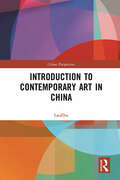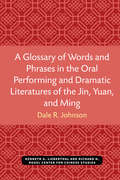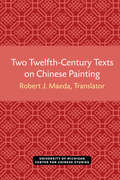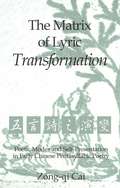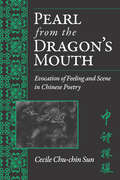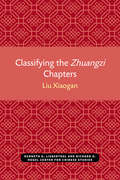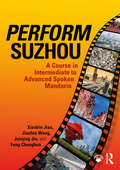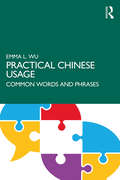- Table View
- List View
Introduction to Contemporary Art in China (China Perspectives)
by Lao ZhuThe book is a collection of fifteen introductory essays excerpted from the Annual of Contemporary Art in China, covering the years from 2005 to 2019, showcasing the development and changing landscapes of contemporary art in China. The Annual documents exhibitions, events, creative practices, and critical literature concerning contemporary art in China since 2005. Based on archival documentation and statistics data from these annuals, notable phenomena, events, and discourses from a given year, as well as key works and artists are reviewed in each introduction, with no ideological or market-driven undertone. The author unravels industrial and institutional factors, while also broaching important issues of abstract art, new media art and so on, and probing the historical and socio-cultural context as well. In this regard, the book offers a panorama of contemporary Chinese art and critically engages with the art scene in China, including Hongkong, Taiwan, and among the Chinese diaspora. The title will appeal to scholars, students and general readers interested in contemporary art history, art criticism, contemporary Chinese art, iconography, and contemporary art theory.
A Glossary of Words and Phrases in the Oral Performing and Dramatic Literatures of the Jin, Yuan, and Ming (Michigan Monographs In Chinese Studies #89)
by Dale R. JohnsonFor many years, the oral performing and dramatic literatures of China from 1200 to 1600 CE were considered some of the most difficult texts in the Chinese corpus. They included ballad medleys, comic farces, Yuan music dramas, Ming music dramas, and the novel Shuihu zhuan. The Japanese scholars who first dedicated themselves to study these works in the mid-twentieth century were considered daring. As late as 1981, no comprehensive dictionary or glossary for this literature existed in any language, Asian or Western. A Glossary of Words and Phrases fills this gap for Western readers, allowing even a relative novice who has resonable command of Chinese to read, translate, and appreciate this great body of literature with an ease undreamed of even two decades ago. The Glossary is organized into approximately 8,000 entries based on the reading notes and glosses found in various dictionaries, thesauruses, glossaries, and editions of works from the period. Main entries are listed alphabetically in the pinyin romanization system. In addition to glosses, entries include symbolic annotations, guides to pronunciation, and text citations. The result is a broadly useful glossary serving the needs of students of this literature as well as scholars researching Jin and Yuan language and its usage.
Two Twelfth-Century Texts on Chinese Painting (Michigan Monographs In Chinese Studies #8)
by Robert J. MaedaTwo Twelfth-Century Texts on Chinese Painting presents two texts in translation that provide dual insight into the Painting Academy of Emperor Hui-tsung and the literati school of painting. The Shan-shui ch’un-ch’uan chi is a treatise for beginning landscape painters dated to the Hsüan-ho era. The treatise was written by Han Cho, a reputed member of the Academy, but the text was not specifically directed at Academicians. The treatise collects and orders previous writings on landscape painting; one of Han Cho’s main goals is to list all landscape definitions and their practical application in painting. Yet his view is more detached and analytical than a stereotypical Academy painter, revealing an approach reminiscent of Confucian scholarship and literati painting as well. The Hua-chi by Teng Ch’un is a history of painting that was written as a sequel to two earlier painting histories. In ten chapters, Teng Ch’un compiles facts and critical evaluations of painters from 1075 to 1167, as well as listings of selected masterpieces. Teng Ch’un provides more specific information about the Academy than Han Cho, discussing its organization and examination system, and noting that “form-likeness” and adherence to rules were leading standards for painting in the Academy. On the other hand, he thinks that painting should transmit “soul,” not just “form.” Thus, Teng Ch’un writes the history of both the establishment values of the Academy and the intellectual tendencies of the literati.
The Matrix of Lyric Transformation: Poetic Modes and Self-Presentation in Early Chinese Pentasyllabic Poetry (Michigan Monographs In Chinese Studies #75)
by Zong-qi Cai Zong-qu CaiPentasyllabic poetry has been a focus of critical study since the appearance of the earliest works of Chinese literary criticism in the Six Dynasties period. Throughout the subsequent dynasties, traditional Chinese critics continued to examine pentasyllabic poetry as a leading poetic type and to compile various comprehensive anthologies of it. The Matrix of Lyric Transformation enriches this tradition, using modern analytical methods to explore issues of self-expression and to trace the early formal, thematic, and generic developments of this poetic form. Beginning with a discussion of the Yüeh-fu and ku-shih genres of the Han period, Cai Zong-qi introdues the analytical framework of modes from Western literary criticism to show how the pentasyllabic poetry changed over time. He argues that changing practices of poetic composition effected a shift from a dramatic mode typical of folk compositions to a narrative mode and finally to lyric and symbolic modes developed in literati circles.
Pearl from the Dragon’s Mouth: Evocation of Scene and Feeling in Chinese Poetry (Michigan Monographs In Chinese Studies #67)
by Cecile C. SunThe interplay between the external world (ching) and the poet’s inner world (ch’ing) lies at the heart of Chinese poetry, and understanding the interaction of the two is crucial to understanding this work from within its own tradition. Closely coordinating her discussions of poetry and criticism so that practice and theory become mutually enriching and illuminating, Sun offers sensitive and original readings of poems and a wealth of insights into Chinese poetics.
Classifying the Zhuangzi Chapters (Michigan Monographs In Chinese Studies #65)
by Xiaogan LiuThe relationships, both historical and philosophical, among the Zhuangzi’s Inner, Outer, and Miscellaneous chapters are the subject of ancient and enduring controversy. Liu marshals linguistic, intertextual, intratextual, and historical evidence to establish an objectively demonstrable chronology and determine the philosophical affiliations among the various chapters. This major advance in Zhuangzi scholarship furnishes indispensable data for all students of the great Daoist text. In a lengthy afterword, Liu compares his conclusions with those of A. C. Graham and addresses the relationship between the Zhuangzi and the Laozi.
Perform Suzhou: A Course in Intermediate to Advanced Spoken Mandarin
by Xiaobin Jian Jianfen Wang Junqing Jia Chenghua FengPerform Suzhou is a task- and performance-oriented textbook course for Chinese study abroad programs serving intermediate- to advanced-level learners. Performance is the key concept; developing communication skills through role playing. Field performance tasks enable students learning Chinese to refine and solidify communication skills by executing real-life tasks in the target culture, before reporting on their experiences in the classroom. The dialogues presented form the basis for improvisation for related contexts, equipping students to respond appropriately in new situations. Perform Suzhou is composed of staged units, drills, exercises and culture notes with accompanying audio. The textbook is accompanied by audio and Action! China, the supporting workbook.
Practical Chinese Usage: Common Words and Phrases
by Emma L. WuPractical Chinese Usage offers post-beginner to near advanced students of Chinese a guide to the most frequently misused and confusing words in the language. Entries are arranged in alphabetical order for ease of reference. Sample sentences with pinyin and English translations are provided after each explanation. Examples of typical mistakes made by students are clearly marked throughou. Each entry is annotated in accordance with the New HSK guidelines, indicating the level of difficulty. Practical Chinese Usage provides students of Chinese with the necessary tools to refine their use of expressions and synonyms in order to communicate effectively in the Chinese language.
